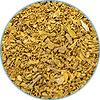
Lifting a sparkling, pure, clean glass of water to your lips and drinking deeply without fear of chemicals, microorganisms, or other contaminants is one of life's small but exquisite pleasures. People may reminisce about the “good old days”, but the truth is that technological advances have made our lives immensely safer, more comfortable, and healthier than has ever been the case before. Modern water filtration is one of these beneficial technologies.
One of the filtering technologies used to supply you and your family with clean, safe water is KDF filtration media. KDF stands for “kinetic degradation fluxion”, and refers to granules of copper-zinc alloy. These granules, or small grains, are produced at a high level of purity to ensure that they function as effectively as possible.
There are several different kinds of KDF media, of which KDF 55 and KDF 85 are the most commonly used in household drinking water filters. KDF media are approved by the U.S. Environmental Protection Agency (EPA). Since the media function slightly differently, most water filters include separate layers of KDF 55 and KDF 85 media to accomplish different tasks.
What KDF media do for you
These copper-zinc granules clean pollutants out of your water by reacting with it in several different ways. Some of the most important effects include:
- KDF 55 catalyzes chlorine electrochemically to transform it into chloride, which dissolves in water. This makes the medium ideal for clearing out the unpleasant smell and taste of chlorine, and suits it to shower filtration systems, too. 99% of chlorine is removed.
- KDF 85 takes about 90% of iron out of water, reducing it to safe levels regardless of whether its source is natural or manmade.
- The process by which KDF media removes heavy metals from the water supply – including mercury, lead, copper, chromium, and nickel, among others – is rather intriguing. The copper and zinc in the KDF set up a constant, low level electrochemical reaction, generating a very weak electric field and altering chemical properties of metals that pass by them. The electrochemical reaction first reduces these metals to an insoluble form, and then actually electroplates them onto the surface of the granules, removing them totally and permanently from the water!
- The electrochemical kills bacteria, fungi, and algae, keeping the filter clean even though it is wet most of the time.
Limitations of KDF media
KDF media obviously help to make your water a lot safer and a lot more pleasant to drink, too. However, they cannot do everything, which is why they are usually accompanied by other filter media arranged in separate layers inside the cartridge.
KDF media do not offer mechanical filtration, so they cannot strain out particles such as Giardia and cryptosporidium cysts, which are strained out using filter pads or carbon blocks with 1 micron absolute pore size or smaller. Nor do they affect most volatile organic compounds (VOCs), which need activated carbon to remove them instead.
However, they perform the invaluable service of taking out heavy metals and other dangerous contaminants, meaning that every good water filter should include them


Share:
Improving the Flavor and Aesthetics of Water with Filtration
Filtering Pesticides out of Your Drinking Water